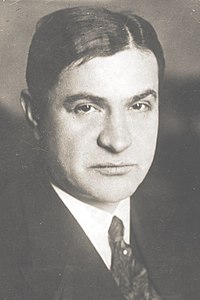Bronisław Pieracki
Bronisław Wilhelm Pieracki | |
|---|---|
 Bronisław Pieracki | |
| Minister of Interior of the Republic of Poland | |
| In office 23 June 1931 – 15 June 1934 | |
| Preceded by | Felicjan Sławoj Składkowski |
| Succeeded by | Leon Kozłowski |
| Personal details | |
| Born | 28 May 1895 Gorlice, Austria-Hungary |
| Died | 15 June 1934 (aged 39) Warsaw, Poland |
| Resting place | Cemetery in Nowy Sącz |
| Nationality | Polish |
| Political party | Nonpartisan Bloc for Cooperation with the Government |
| Occupation | Politician, military officer |
| Military service | |
| Branch/service | Polish Army |
| Battles/wars | Polish-Ukrainian War |
Bronisław Wilhelm Pieracki (28 May 1895 in Gorlice - 15 June 1934 in Warsaw) was a Polish military officer and politician. As a member of Polish Legions in World War I, Pieracki took part in the Polish-Ukrainian War (1918–1919) and he later supported the 1926 May Coup of Józef Piłsudski. Pieracki was a deputy in the Polish Sejm from the Nonpartisan Bloc for Cooperation with the Government in 1928 and afterwards deputy Chief of Staff.
He was a minister of internal affairs from 27 May 1931[1] to the time of his death in 1934 and posthumously awarded Poland's highest civilian and military decoration, the Order of the White Eagle.
Assassination[]
On 15 June 1934, Pieracki was assassinated by a member of the Organization of Ukrainian Nationalists. His death gave Poland's Sanation government a justification to create, two days after the assassination, the Bereza Kartuska Prison. The prison's first detainees were almost entirely the leadership of the Polish nationalist far-right National Radical Camp (the ONR), arrested on 6–7 July 1934.[2]
Sentenced to death in the Pieracki assassination were Stepan Bandera and Mykola Lebed. Their sentences were commuted to life imprisonment, and Lebed escaped when Germany invaded Poland in 1939.[3]
Honours and awards[]
- Order of White Eagle
- Order of Polonia Restituta
- Silver Cross of the Virtuti Militari
- Cross of Valour - four times
- Gold Cross of Merit
- Order of the Cross of the Eagle Class I (Estonia, 1934)
See also[]
References[]
- ^ Robin L. Bidwell, "Bidwell's Guide to Government Ministers Vol.1, The major powers and western Europe, 1900-1971", Frank Cass & Co Ltd, 1973, ISBN 0-7146-2977-4, p. 191.
- ^ Rudnicki, Szymon (1977). "Rozbicie ruchu młodzieżowego "Obozu Narodowego"". Dzieje Najnowsze. 9 (1): 23–46 (43).
- ^ Breitman, Richard; Norman J.W. Goda (2010). Hitler's Shadow: Nazi War Criminals, US Intelligence, and the Cold War (PDF). National Archives. p. 73. Retrieved 2010-12-12.
Further reading[]
- (in Polish) Andrzej Misiuk Białym żelazem, Gazeta Wyborcza, 12/07/1994.
| Wikimedia Commons has media related to Bronisław Pieracki. |
- 1895 births
- 1934 deaths
- People from Gorlice
- Nonpartisan Bloc for Cooperation with the Government politicians
- Assassinated Polish politicians
- Interior ministers of Poland
- Polish Army officers
- Polish legionnaires (World War I)
- People murdered in Poland
- Recipients of the Order of Polonia Restituta
- Recipients of the Silver Cross of the Virtuti Militari
- Recipients of the Cross of Valour (Poland)
- Recipients of the Gold Cross of Merit (Poland)
- Recipients of the Military Order of the Cross of the Eagle, Class I
- Victims of OUN-B killings
- Recipients of the Order of the White Eagle (Poland)